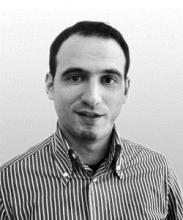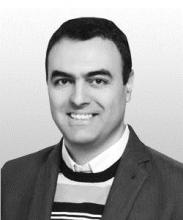Machine Vision
Overview
Contents
- Introduction to computer vision
- Cameras and optics
- Brightness and color
- Pixels and filters
- Image processing in frequency domain
- Image pyramid
- Machine learning:
- Clustering and classification
- Edge detection and line overlapping
- Robust line overlapping (Hough transformation, RANSAC, etc.)
- Clustering and image segmentation
- Gaussian Mixture Models (GMM)
- Points of interest detection
- Feature tracking
- Optical flow
- Stereo correspondence
- Scaling- and rotation-invariant feature transformation (SIFT, SURF)
- Visual words dictionaries
- Recognition and classification of visual objects
Testimonials
The course consisted of a theoretical part and a practical part. The lectures were 2 hours (theory) and 1 hour (programming exercises) per week. All material and lectures were in English. From October to mid-December we learnt the basic image processing, pixel manipulations, filters, edge detection, feature matching, etc. From mid-December onward we learnt about deep learning. There are no Christmas holidays in Macedonia, so be prepared to have lectures during this time.
We had two exams in mid-December: The theoretical exam was two questions to answer essay-like, 30 minutes time. The practical exam was one problem solving task (programming) for which we had 24 hours and it had a workload of approx. 2 to 3 hours (keep in mind you probably have other lectures or exercises during this 24 hours). Only the students who passed the two exams could make a seminar work. It was within a deep learning topic recommended by the lecturer; you could also choose your own topic.
The grading structure was:
- 20% theoretical exam
- 30% practical exam
- 50% seminar work
Overall, this course gave a complete introduction to image processing and deep learning. For the programming we used Jupyter Lab, OpenCV and PyTorch.
Outcomes
The goal of this course is to introduce the students to the basic concepts and principles of computer vision.
The students who will successfully finish the course will be able to
- Design efficient systems for computer vision for handwriting recognition
- Detection and recognition of faces
- Movement detection
- Human and vehicle tracking
- Gesture recognition
- Classification and recognition of visual objects
- Scene analysis and understanding
- Etc.
Methods & Schedule
The course consists of a theoretical part and a practical part. The lectures are 2 hours (theory) and 1 hour (programming exercises) per week during the day and will be provided in hybrid mode (on-campus lecture + webinar room). Additionally, there will be some recordings of the lectures for watching at a later time.
Lectures using presentations, interactive lectures, exercises (using equipment and software packages), teamwork, case studies, invited guest lecturers, independent preparation and defense of a project assignment and seminar work.
| Type | Effort [h] |
|---|
| Lectures | 30 |
| Exercises | 45 |
| Project Tasks | 15 |
| Independent Learning Tasks | 15 |
| Home Learning | 75 |
Materials
| Author | Title | Publisher | Year |
|---|
| Richard Szeliski | Computer Vision: Algorithms and Applications | Microsoft Research | 2010 |
| D.A. Forsyth and J. Ponce | Computer Vision: A Modern Approach | Prentice Hall | 2002 |
| N. Sebe, M.S. Lew | Robust Computer Vision: Theory and Applications (Computational Imaging and Vision) | Springer | 2003 |
Assessment
The assessment consists of a practical assignment and a final exam, which is sufficient to pass the course. After that, you can do a seminar work/project (optional) from January to March to improve the grade. Please consider the additional effort which might be during your summer semester.
Methods
| Type | Points/Percent |
|---|
| Tests (assignments) | 30 points |
| Seminar paper / Project | 40 points |
| Activity and Learning | 10 points |
| Final exam (theory) | 20 points |
Criteria
| Grade | Grade (letter) | Scale |
|---|
| 5 | F | up to 50 points |
| 6 | E | 51 to 60 points |
| 7 | D | 61 to 70 points |
| 8 | C | 71 to 80 points |
| 9 | B | 81 to 90 points |
| 10 | A | 91 to 100 points |
Requirements
Level
Intermediate
Skills
Equipment





